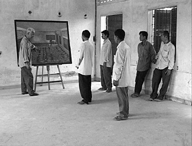S21, the Khmer Rouge Killing Machine
S21, la machine de mort Khmère rouge FRANCE / 2002 / Cambodian / Color / Video / 101 min
FRANCE / 2002 / Cambodian / Color / Video / 101 min
Director, Script: Rithy Panh
Photography: Prum Mésar, Rithy Panh
Editing: Marie-Christine Rougerie, Isabelle Roudy
Sound: Sear Vissal
Music: Marc Marder
Producer: Cati Couteau
Production Companies: INA, Arte France Source: INA
World Sales: MK2
55 rue Traversière, 75012 Paris FRANCE
Phone: 33-1-44-67-30-00 Fax: 33-1-43-07-29-63
E-mail: or.veillon@mk2.com
“S21” is the name of a former concentration camp for political prisoners in Cambodia. Former victims and tormentors caught up in the atrocities committed by the Khmer Rouge are reunited, and relive the inhumanity and cruelty of their days here. Facts that are brought to light by evidence presented here, and the vividness of the exchanges between two former adversaries transcend the twenty-five years that have passed. This film silently pulsates with the emotion felt by Cambodian-born director Rithy Panh toward his homeland.
[Director’s Statement] In Cambodia under the Khmers Rouge, S21 was the main “Security Bureau.” In this detention center located in the heart of Phnom Penh, some 17,000 prisoners were tortured, interrogated and then executed from 1975 to 1979. Only three of them are still alive.
This film is an attempt to understand how the Communist Party of Democratic Kampuchea organized and implemented its policy of systematic elimination.
For some three years, we the filmmakers investigated not only the few escapees, but also their former torturers. We persuaded both groups to return to the actual site of what was formerly S21, now converted into a Genocide Museum, to confront their testimonies.
The leaders, those who were truly responsible for what happened, are walled in by their denials of any responsibility. This process does not concern them.
Words cannot suffice to describe what took place there. The implacable and meticulous operation of the machinery of carefully planned murder is beyond our understanding. It is as though the conscience cannot take it in, and today puts words on something that cannot be told. But evidence remains—photographs, archives, places—which bring back the words from the past. There is also the memory buried deeply inside the bodies, that of gestures and routines that can spring up out of the unconscious as in a nightmare.
The singularity of the film lies in a confrontation between the determination of those who escaped, who want to understand so that they can pass on what happened and protect future generations, and the words of the jailers, who seem to be stupefied to relive the horror to which they contributed.
It is necessary for certain things to be said to return to the victims their destiny and their memory. They must also be said so that reflection about the past can help in the construction of the present.
 Rithy Panh
Rithy Panh
Born in Phnom Penh. Graduated from the Institut des Hautes Etudes Cinématographiques (IDHEC), Paris. Has made numerous award-winning theatrical and documentary features. Site II (1989) won the Grand Prize at the Amiens International Film Festival. “NEAK SRE” The People of the Rice Field (1994) and One Fine Evening after the War (1996–97) were shown at the Cannes Film Festival, and the latter was screened at the Tokyo International Film Festival in 1998. Other works awarded prizes at international film festivals include Bophana, a Cambodian Tragedy (1996) and The Land of the Wandering Souls (2000), awarded the Robert and Frances Flaherty Prize at YIDFF 2001. S21, the Khmer Rouge Killing Machine (2002) also screened at the Cannes Film Festival in 2003. Currently working on The People of Angkor. |
